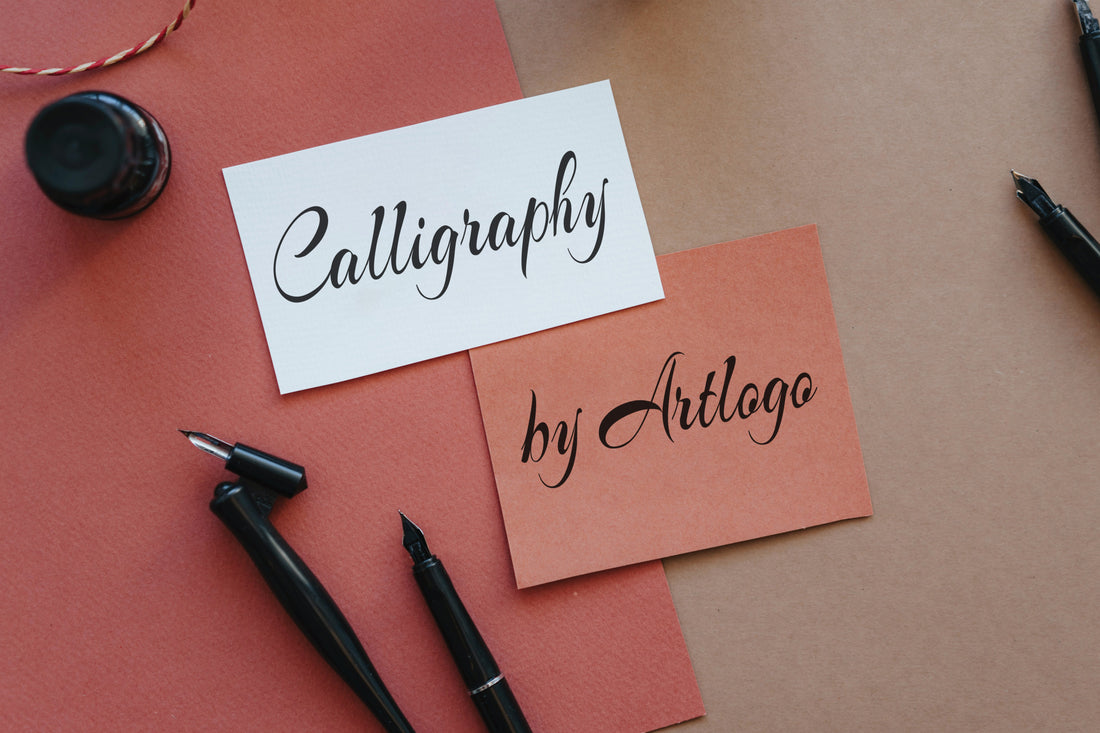Calligraphy is a timeless art that captivates people for centuries. From elegant handwritten letters to intricate designs, calligraphy is the art of beautiful writing. But what exactly is calligraphy? In this article, we'll explore calligraphy - its history, techniques, and diverse styles. Whether you're a beginner or an experienced calligrapher, discover the exquisite artistry and meticulous craftsmanship of this ancient form.
What Is Calligraphy: History, Origins and Uses
How To Write Calligraphy: Step-by-Step
Calligraphy vs Cursive: What’s The Difference?
How To Use a Calligraphy Pen: Step-by-Step
What Is Calligraphy: History, Origins and Uses
What Is Calligraphy?
Calligraphy is the art of writing beautifully. It involves using specific tools and techniques to create elegant and visually appealing letters and designs. "Calligraphy" comes from the Greek words "kallos," meaning beauty, and "graphein," meaning to write.
Origins Of Calligraphy
Calligraphy finds its origins in ancient civilizations like Egypt and Mesopotamia. These societies created their own unique writing systems, and calligraphy transformed writing into an artistic expression.
In Egypt, hieroglyphics served as a form of calligraphy, featuring intricate symbols and designs carved into stone. Hieroglyphics conveyed both meaning and beauty, not just writing.
In Mesopotamia, cuneiform script was developed, which involved using a stylus to make wedge-shaped impressions on clay tablets. This script was used for a variety of purposes, including administrative records and religious texts. The cuneiform script evolved over time, becoming more sophisticated and aesthetically pleasing.
In China, calligraphy has a long and rich history. Chinese calligraphy is considered one of the highest forms of art in Chinese culture. It involves using a brush and ink to create strokes and characters with varying thickness and rhythm. Chinese calligraphy goes beyond mere writing. It is a captivating form of expression that conveys emotions and the exquisite beauty of characters in a meaningful way.
What Are The Different Types Of Calligraphy?
Different Styles and Types of Calligraphy:
This style includes various scripts such as Gothic, Italic, Uncial, and Copperplate. Each script has its own unique characteristics and historical significance.
Chinese calligraphy encompasses multiple styles, including Regular Script, Running Script, Cursive Script, and Seal Script. Each style emphasizes different strokes and techniques.
- Japanese Calligraphy:
Known as Shodo, Japanese calligraphy is heavily influenced by Chinese calligraphy. It includes different styles such as Kaisho, Gyosho, and Sosho, each with its own rules and characteristics.
- Arabic Calligraphy:
Islamic calligraphy, also known as Arabic script, holds great esteem in the Islamic world. It encompasses different styles like Naskh, Thuluth, and Diwani, each boasting its unique aesthetic charm.
- Indian Calligraphy:
Indian calligraphy encompasses scripts such as Devanagari, Bengali, and Tamil. These scripts are used in various Indian languages and have their own distinct styles and flourishes.
Persian calligraphy, also known as Farsi calligraphy, is based on the Persian script. It includes styles such as Nasta'liq, Shekasteh, and Ta'liq, each with its own elegance and complexity.
- Tibetan Calligraphy:
Tibetan calligraphy is associated with Buddhist art and culture. It involves writing in the Tibetan script, which has its own unique style and beauty.
- Korean Calligraphy:
Known as Seoye, Korean calligraphy has a long history and is deeply rooted in Korean culture. It includes styles such as Kaishu, Gyosho, and Sosho, each with its own characteristics and artistic appeal.
Hebrew calligraphy, also known as Jewish calligraphy, is based on the Hebrew script. It includes styles such as Ashurit, Rashi, and Sephardic, each with its own artistic flair and religious significance.
- Latin Calligraphy:
Latin calligraphy refers to the calligraphy of the Latin alphabet. It includes scripts such as Carolingian, Gothic, and Roman, each with its own historical importance and artistic style.
These are a few examples of the various types of calligraphy found worldwide, showcasing its rich diversity. Each style has its own unique characteristics, techniques, and cultural significance. Whether Chinese calligraphy's elegance or Arabic calligraphy's intricacy, it has captivated people for centuries. Calligraphy is a beautiful art form.

Is Calligraphy Still Used In Todays Age?
Yes, calligraphy is still used in today's age. While it may not be as widespread or commonly practiced as it once was, calligraphy continues to be appreciated and utilized in various ways.
One area where calligraphy is still commonly used is in the creation of formal invitations, such as lettering, wedding invitations or event announcements. Many people prefer the elegance and personal touch that calligraphy adds to these special occasions.
In addition to invitations, calligraphy is also used in the design of logos, branding, and packaging. Many businesses and organizations opt for hand-lettered calligraphy to create a unique and distinctive visual identity.
Furthermore, calligraphy is still practiced as a form of artistic expression. Many artists continue to explore and experiment with calligraphy, creating stunning graphics and visual art pieces that blend traditional techniques with contemporary styles. Calligraphy workshops and classes are also available, allowing individuals to learn and develop their own calligraphic skills.
What Tools Are Used For Calligraphy?
Calligraphy is a beautiful art form that involves writing in a decorative and elegant manner. It requires precision, skill, and the right writing instruments to create stunning calligraphic pieces. Here are some of the tools commonly used in calligraphy:
- Nibs: Nibs are the primary tools used in calligraphy. They are metal or plastic tips that are inserted into a pen holder. Nibs come in various shapes and sizes, each producing a different type of stroke. Some popular nib styles include pointed, italic, and broad-edge nibs.
- Pen Holders: Pen holders, also known as pen handles, are used to hold the nib securely. They come in different materials such as wood, plastic, or metal. The shape and weight of the pen holder can affect the control and comfort of the calligrapher. Fountain pens are among the most common and what we are used to seeing in todays age.
- Ink: Calligraphy ink is specially formulated to flow smoothly and evenly. It comes in different colors like black, blue, red, and gold. Ink can be purchased in bottles or cartridges, depending on the preference of the calligrapher.
- Paper: Choosing the right paper is crucial in calligraphy. Smooth and absorbent paper is preferred as it allows the ink to flow smoothly and prevents bleeding. Calligraphy paper usually has a specific weight and texture to enhance the writing experience.
- Brushes: In some calligraphic styles, brushes are used instead of pens. These brushes have soft bristles that allow for more fluid strokes. They are typically used in Eastern calligraphy, such as Chinese or Japanese calligraphy.
- Watercolor or Ink Colors: Calligraphers may use watercolor or colored ink to add vibrancy and variety to their pieces, applying these hues with a brush or pen.
- Ruler or T-square: A ruler or a T-square is used to create straight lines or to measure the spacing between letters or words. This tool helps ensure precision and consistency in the artwork.
- Erasers and correction fluid: Mistakes happen, even in calligraphy. Erasers and correction fluid are used to fix errors or smudges on the paper. Care must be taken when using these tools to avoid damaging the artwork.
- Drying rack: A drying rack is used to place calligraphic pieces to dry. This prevents smudging or smearing of the ink while it dries.
- Illumination materials: In certain calligraphy styles, like Western medieval calligraphy, gold leaf, silver leaf, or pigments are used to decorate and embellish artwork.
Calligraphy can be done with various tools and techniques, not limited to handwriting. These are just a few of the tools commonly used in calligraphy. Calligraphers may also use additional tools or materials depending on their preferred style or technique. Experimentation and personal preference play a significant role in the choice of tools for each calligrapher.
How Has Calligraphy Evolved Over Time?
The Phoenician alphabet was a major milestone in calligraphy, influencing subsequent writing systems. This alphabet introduced a simplified set of characters that could be easily written and engraved, leading to a more efficient and standardized form of calligraphy.
Throughout history, various cultures and regions have contributed to the evolution of calligraphy. The Greeks, for instance, developed the elegant and geometrically precise script known as the Uncial script. The Romans then adapted and refined the Uncial script into the more familiar Roman cursive and capital lettering styles.
During the Middle Ages, calligraphy reached its peak in Europe with the development of Gothic scripts. These scripts showcased elaborate flourishes, intricate letterforms, and high contrast in stroke thickness. This style of calligraphy was widely used for religious manuscripts and illuminated texts.
With the printing press invention in the 15th century, calligraphy declined as printed materials became more accessible and affordable. However, calligraphy continued to be practiced by monks and scribes, who preserved the art form and passed down their knowledge and techniques.
In the 20th century, calligraphy experienced a comeback as artists and designers integrated handcrafted elements into their work. This gave rise to modern calligraphy, blending traditional forms with contemporary design. Today, calligraphy evolves as artists explore new tools, materials, and digital technologies. Some artists have embraced digital tools and software to create digital calligraphy, while others still work with traditional tools and techniques.
The internet and social media have greatly impacted calligraphy's evolution. Artists can now share their work with a global audience, connect with peers, and learn different techniques. Calligraphy has come a long way from its ancient roots and remains a dynamic art form. Whether it's traditional or modern, handcrafted or digital, calligraphy remains a beautiful and expressive way to communicate through the written word.
How To Write Calligraphy: Step-by-Step
Step 1: Gather Your Materials
Prior to beginning calligraphy, having the right tools and materials is crucial. Here's what you'll need:
- Calligraphy pen:
Choose a pen that suits your style and comfort. Different types of calligraphy pens include dip pens, fountain pens, and brush pens. Try out different pens to discover the one that suits you best.
- Nib:
The nib is the metal tip of the calligraphy pen that holds and releases the ink. It comes in various sizes and shapes: pointed, broad, or italic. Start with a medium-sized nib for beginners.
- Ink:
Use high-quality calligraphy ink specifically made for calligraphy pens. Select colors to enrich your writing with depth and character.
- Paper:
Choose a smooth and thick paper that can handle the ink without bleeding or feathering. Practice sheets with guideline grids can be helpful for beginners to maintain consistent letter size and spacing.
- Ruler and pencil:
These tools will come in handy for drawing guidelines and maintaining symmetry in your calligraphy.
Step 2: Learn the Basic Strokes
Calligraphy is based on a set of fundamental strokes that form the building blocks of letters and words. These strokes include thin upstrokes and thick downstrokes. Practice these basic strokes to train your hand and get a feel for the pen's pressure.
Step 3: Study Different Calligraphy Styles
Explore different calligraphy styles like Gothic, Italic, Copperplate, and Modern Calligraphy. Research and learn about them to find your preferred one. Each style has unique characteristics and techniques, so understand them before starting calligraphy practice.
Step 4: Practice, Practice, Practice
Calligraphy is a skill that requires practice and patience. Set aside dedicated time each day to practice your strokes and letters. Start by practicing individual letters, then move on to words and phrases. Gradually increase the complexity of your practice exercises to challenge yourself and improve your skills.
Step 5: Focus on Consistency and Precision
One of the key aspects of calligraphy is consistency and precision. Pay attention to the size, spacing, and slant of your letters to create a visually pleasing and balanced piece. Use guidelines to help you maintain consistency in your letterforms.
Step 6: Experiment and Explore
Once you grasp the fundamentals, don't hesitate to explore and experiment. Try different tools, inks, and papers to see how they affect your writing. Experiment with flourishes and embellishments to personalize your calligraphy.
Step 7: Seek Inspiration and Feedback
To improve calligraphy skills, draw inspiration from other calligraphers and artists. Follow calligraphy blogs, join online communities, and attend workshops and classes. Additionally, seek feedback from more experienced calligraphers to help you identify areas for improvement and refine your technique.
Remember, calligraphy is a journey that requires time to develop your unique style. Be patient with yourself and enjoy the process. With consistent practice and a passion for the art, you will see progress and develop your own beautiful calligraphy style.

How Do I Keep My Lines Consistent?
Keeping your lines consistent in calligraphy requires attention to detail and practice. Here are a few tips to help you maintain consistency in your letterforms. First, use guidelines or grid paper to create a visual guide for your letters. This will help you keep your strokes straight and evenly spaced.
Secondly, pay attention to the angle and pressure of your pen or brush. Consistent pressure and angle will result in consistent line thickness throughout your writing. Practice hand lettering vertically and horizontally repeatedly until you develop a consistent and effortless stroke.
Additionally, practice your strokes and letters regularly to build muscle memory and control. Additionally, practice your strokes and letters regularly to build muscle memory and control. Take your time and be patient with yourself. Developing consistency requires time, so don't get discouraged if it's not easy at first. With practice and attention to detail, you will gradually improve and achieve the consistent lines you desire in your calligraphy.
Can Calligraphy Only Be Done In Cursive?
No, calligraphy isn't just limited to cursive. Cursive calligraphy is popular, with numerous ways, styles letterforms to explore. Some calligraphers prefer a more traditional, formal style, while others may experiment with more modern or decorative styles. It depends on your preference and desired look. Experiment with various styles to discover what suits you best. Remember, calligraphy is about expressing your own unique style and creativity.
How Do I Create Curves and Flourishes For My Calligraphy?
- Master the basics:
Before you dive into creating curves and flourishes, it's important to have a solid foundation in basic calligraphy techniques. Make sure you're comfortable with holding your pen properly, applying consistent pressure, and forming basic strokes. Mastering these fundamentals until you feel confident in your abilities.
- Choose the right tools:
To create beautiful curves and flourishes, you'll need the right tools and utensils. A flexible nib is essential for achieving smooth and flowing lines. Experiment with different nibs to find the one that suits your style and preference. Additionally, make sure you have high-quality ink and smooth paper that won't cause any disruptions in your strokes.
- Slow down and take your time:
When it comes to creating curves and flourishes, precision is key. Slow down your strokes and focus on maintaining a consistent speed and pressure. Rushing through the process can result in messy and uneven lines. Remember, calligraphy is all about attention to detail.
- Practice basic curves:
Start by practicing basic curves to get a feel for the motion. Begin with a downward stroke and gradually apply pressure as you move the pen upwards, creating a smooth curve. Repeat this motion several times until you feel comfortable with the movement. Then, try creating curves in different directions, such as upward and diagonal. Remember to maintain a light touch and steady pressure throughout.
- Experiment with flourishes:
Once you've mastered basic curves, you can start adding flourishes to your calligraphy. Flourishes are decorative extensions that can be added to letters or words to enhance their beauty. Start by practicing simple flourishes, such as loops or curls, at the beginning or end of your letters. As you gain confidence, you can experiment with more complex and intricate flourishes. Remember to keep a consistent flow and rhythm as you add these decorative elements.
- Study and learn from others:
Look for inspiration from experienced calligraphers and study their work. Analyze how they create curves and flourishes and try to replicate their techniques. Don't hesitate to experiment and develop your unique style. The more you observe and practice, the better you'll get at creating beautiful curves and flourishes in calligraphy.
What Is Faux Calligraphy?
Faux calligraphy mimics traditional calligraphy using everyday writing utensils like pens and markers. Unlike the traditional version, which needs specialized tools like a dip pen and ink, faux calligraphy can be done by anyone. The term "faux" refers to its imitation of traditional calligraphy. However, this doesn't mean that faux calligraphy is any less impressive or beautiful. Its popularity has grown in recent years because of its easy access and adaptability.
What's The Difference Between Modern Calligraphy and Traditional Calligraphy?
Modern and traditional calligraphy are exquisite forms of the art of writing; however, they exhibit distinct variations.
- Style and Aesthetic:
Traditional calligraphy follows specific letterforms and rules that have been established over centuries. It is often associated with formal and classic designs. On the other hand, modern calligraphy embraces a looser and more contemporary style. It allows for more experimentation and personal expression, often incorporating elements of handwriting and other artistic influences.
- Tools and Techniques:
Traditional calligraphy is typically done with a fountain pen, dip pen or a brush using specific types of ink, such as Indian ink or gouache. The tools and techniques used are often more rigid and structured. Modern calligraphy can be done with various tools like brush pens, markers, or regular pens and pencils. It offers flexibility and room for experimentation with different inks and mediums.
- Rules and Guidelines:
Traditional calligraphy follows rules and guidelines for letterform proportions, spacing, and stroke order. These rules ensure consistency and uniformity in the writing. Modern calligraphy, on the other hand, doesn't have strict rules. It encourages the artist to break free from tradition and incorporate their own unique style.
- Purpose and Application:
Traditional calligraphy is often associated with formal documents, such as wedding invitations, certificates, or important manuscripts. It is commonly used for special occasions or to add a touch of elegance to important written materials. Modern calligraphy is versatile and applicable to various projects and mediums. It can be used in branding, graphic design, personal artwork and worksheets, and even digital media.

Does Knowing Cursive Translate To Knowing Calligraphy?
Knowing cursive does not necessarily translate to knowing calligraphy. While cursive writing may share some similarities with certain calligraphy styles, calligraphy requires specific skills and techniques that go beyond simply connecting letters. Calligraphy involves a greater focus on letterforms, stroke order, and creating consistent and intentional lines.
Knowing cursive can be a helpful foundation for learning calligraphy, it is not a guarantee of proficiency in the art form. Calligraphy requires additional dedication and practice to develop the necessary skills and achieve the desired level of mastery.
Are There Any Unique Effects I Can Incorporate Into My Modern Calligraphy?
Yes, you can incorporate many unique effects into your modern calligraphy. Some popular effects include:
- Bounce lettering: This technique involves adding a playful and dynamic rhythm to your letterforms by varying the height and width of the strokes. It gives your calligraphy a lively and energetic look.
- Flourishes: Flourishes are decorative elements that can be added to the beginning or end of letterforms. They can range from simple curls to elaborate swirls and loops. Flourishes can add elegance and sophistication to your calligraphy.
- Watercolor blending: If you're using watercolor inks or paints, you can create beautiful gradient effects by blending different colors together. This adds depth and dimension to your calligraphy.
- Shadowing: Adding shadows to your letterforms can create a 3D effect and make them appear more visually striking. You can achieve this by using a darker shade of ink or by adding shading with a brush or marker.
- Embellishments: You can add decorative elements such as dots, stars, hearts, or other small illustrations to enhance your calligraphy and make it more personalized.
- Mixing different styles: Modern calligraphy lets you combine various lettering styles, like script, serif, and sans-serif, for unique and visually engaging compositions. Remember, the key to incorporating unique effects into your modern calligraphy is to practice, experiment, and develop your own personal style.
What Are Some Drills I Can Do To Enhance My Calligraphy Skills?
To enhance your calligraphy skills, there are several drills you can practice. These drills focus on improving your letterforms, stroke order, and consistency. One drill you can do is the basic stroke drill, where you repeatedly practice making straight lines, curves, and loops. This helps improve your control over the pen and your ability to create consistent lines.
Another drill is the letterform drill, where you practice writing each letter of the alphabet multiple times, focusing on maintaining consistent size, shape, and spacing. This drill helps you become more familiar with the letterforms and develop muscle memory.
Additionally, you can practice the connecting stroke drill, where you write words or phrases with an emphasis on connecting each letter smoothly and seamlessly. This drill helps improve your flow and transition between letters.
Calligraphy vs Cursive: What’s The Difference?
What Is Cursive?
Cursive is a style of handwriting that is characterized by the flowing and connected of joined letters. It is a practical and efficient way of writing, as it allows for faster and more fluid writing compared to print writing. Cursive writing is commonly taught in schools and is often used for everyday writing tasks such as note-taking, writing letters, and completing assignments.
The origins of cursive writing can be traced back to ancient times. It was widely used by the Romans and later adapted and developed by various cultures and civilizations. In the US, cursive writing was once taught in schools. However, its usage and instruction have declined due to the rise of digital communication in recent times.
What's The Differences Between Calligraphy and Cursive?
While calligraphy and cursive both involve handwriting, there are several key differences that set them apart:
- Style: Cursive writing is more practical and utilitarian, focusing on speed and efficiency, while calligraphy is more artistic and decorative, emphasizing precision and visual appeal.
- Tools and techniques: Cursive writing can be done with any writing instrument, while calligraphy typically requires specialized tools such as pens, brushes, and ink. Calligraphy also involves specific techniques such as pressure, thick and thin stroke variations to create different scripts and visual art representations of lettering.
- Purpose and applications: Cursive writing is commonly used for everyday writing tasks, such as note-taking and completing assignments. Calligraphy, on the other hand, is often used for special occasions and formal events, where an elegant and artistic touch is desired.
- Training and skill level: Cursive writing is typically taught in schools and can be learned by anyone with practice. Calligraphy, however, requires more skill and training to master its intricate letterforms and artistic techniques.
Can Calligraphy and Cursive Writing Be Used Interchangeably?
Calligraphy and cursive writing may seem similar at first, but they are distinct forms of writing. While they both involve fluid, strokes and connections each has its own unique characteristics and purposes. Therefore, calligraphy and cursive writing cannot be used interchangeably.
How Do The Two Handwriting Styles Compare In Terms Of Complexity?
In terms of complexity, calligraphy generally requires more time, practice, and attention to detail compared to cursive writing. Calligraphers must learn different scripts and study the characteristics and nuances of each style. They need to master techniques like creating thick downstrokes and thin upstrokes, achieving consistent letterforms, and understanding spacing and layout principles.
Cursive writing, on the other hand, is quickly learned and often introduced at a young age in schools. It focuses on developing a simple, consistent and legible style, as well as maintaining the flow and rhythm of the writing. While cursive writing may not require as much precision and attention to detail as calligraphy, mastering it still requires practice and dedication.
Are There Different Styles Of Calligraphy and Cursive Writing?
Beginning with calligraphy, various renowned styles have emerged from diverse cultures and historical eras. Here are a few notable calligraphy styles:
- Copperplate: This elegant and ornate style of calligraphy originated in England during the 18th century. Copperplate calligraphy is characterized by its slanted and flowing letterforms, which are created using a pointed pen.
- Gothic: Also known as Blackletter, this style of calligraphy originated in medieval Europe. It is recognized for its bold, angular letterforms, which often have intricate details and flourishes.
- Italic: Italic calligraphy is a modern style that emerged during the Renaissance. It is characterized by its slanted, flowing letterforms that have a slight tilt to the right. Italic calligraphy is often used for its legibility and versatility.
- Uncial: Uncial calligraphy originated in ancient Rome and was later adopted by Irish and Scottish monks. It is known for its rounded and curved letterforms, which are often written with a broad-nibbed pen.
These are just a few examples of the numerous calligraphy styles that exist. Each style has its own unique characteristics and history, making calligraphy a rich and diverse art form.
Similarly, cursive writing also has its own styles and variations. Some popular cursive writing styles include:
- Palmer Method: Developed by Austin Palmer in the late 19th century, the Palmer Method is a simplified cursive writing style that focuses on efficiency and legibility. It features rounded and flowing letterforms with a slight slant to the right.
- D'Nealian: Created by Donald Thurber in the 1970s, the D'Nealian style aims to bridge the gap between manuscript printing and cursive writing. It features a combination of print and cursive letterforms, making it easier for young learners to transition from printing to cursive.
- Spencerian: Developed by Platt Rogers Spencer in the 19th century, the Spencerian style is known for its elegant and ornamental letterforms. It features flowing and elaborate curves, making it a popular choice for formal and decorative purposes.
- Zaner-Bloser: Created by Charles Zaner and Elmer Bloser in the early 20th century, the Zaner-Bloser style is widely taught in American schools. It features a simplified and legible cursive writing style with clear letterforms and consistent slant.
How To Use a Calligraphy Pen: Step-by-Step
What Is a Calligraphy Pen?
A calligraphy pen is a specialized writing instrument that is designed for creating beautiful and decorative lettering. Unlike regular pens, calligraphy pens have a unique nib (the metal tip) that allows for different line widths and styles. These pens are compatible with different types of ink, including traditional ink as well as modern alternatives like markers or brush pens. Calligraphy pens come in different styles like dip pens, fountain pens, and markers, each with unique advantages and characteristics. The choice of pen depends on personal preference and the type of calligraphy you wish to create.
How To Use a Calligraphy Pen
Step 1: Choose the right pen
To start using a calligraphy pen, first, select the one that suits your needs. Take into account factors like the desired calligraphy style, your level of experience, and personal preferences when choosing from various available types of calligraphy pens. Dip pens are great for beginners as they allow for more control, while fountain pens offer convenience and ease of use. Try out various pens to discover the one that feels most comfortable in your hand and achieves the desired results.
Step 2: Prepare your pen
Before using your calligraphy pen, it is important to prepare it correctly. For a dip pen, securely attach the nib to the pen holder, ensuring it is clean and free from residue or ink buildup. If using a fountain pen or marker, make sure it is filled with ink or has a fresh cartridge inserted.
Step 3: Choose your ink
Next, select your ink. Traditional calligraphy ink comes in different colors and is often mixed with water for a thinner consistency. For a dip pen, dip the nib into the ink and let it soak for a few seconds. For fountain pens or markers, refer to the manufacturer's instructions to fill or prime the pen with ink.
Step 4: Hold the pen correctly
Proper grip and posture are essential for achieving clean and precise calligraphy strokes. Hold the pen in a relaxed manner, with your fingers resting lightly on the pen. The nib should be slightly horizontal, for best results aim for a 45-degree angle to the paper, allowing for smooth and consistent ink flow. Position your hand and arm in a way that feels comfortable and allows for controlled movements.
Step 5: Practice basic strokes
Before you start writing letters, it's important to practice basic calligraphy strokes. This will help you get a feel for the pen and develop control over your movements. Start with simple upstrokes and downstrokes, applying varying pressure to create different line widths. Practice curves and loops to achieve fluidity in your strokes. Take your time and focus on consistency and precision.
Step 6: Start writing letters
Once you feel confident with the basic strokes, you can start writing letters. Begin with simple letterforms and gradually progress to more complex ones. Pay attention to the spacing and alignment of your letters, as well as the overall balance of your writing. Practice regularly to improve your skills and develop your own unique style.
Step 7: Clean and maintain your pen
After each use, it's important to clean your calligraphy pen to prolong its lifespan. Rinse the nib with warm water, gently removing any ink residue or buildup. Dry the nib thoroughly before storing it. If you're using a fountain pen, follow the manufacturer's instructions for regular cleaning and maintenance.

When Was The First Calligraphy Pen Used?
The first calligraphy pen was used thousands of years ago in ancient civilizations such as Egypt and China. These early calligraphy pens were typically made from reeds or bamboo and had a split nib that allowed for the controlled flow of ink. Calligraphy has a rich and extensive history. Calligraphy pens have evolved over time, offering a multitude of materials and designs. Today, there is a wide selection of calligraphy pens in various styles and sizes. These pens enable artists and enthusiasts to explore different techniques and create stunning lettering. Irrespective of your expertise, a calligraphy pen has the power to elevate your writing and breathe life into your artistic expression.
What Is The Best Way To Hold a Calligraphy Pen?
Proper technique is crucial for pen-holding. It greatly impacts stroke flow & control. Here is the best way to hold a calligraphy pen.
- Grip:
Start by holding the pen between your thumb and index finger. Place your thumb on one side of the pen and let your index finger rest on the opposite side. The pen should rest just above the first knuckle of your index finger.
- Position:
Position your hand slightly above the writing base, allowing your pen to glide smoothly across the paper. Your hand should be at a comfortable angle, neither too vertical nor too horizontal. Experiment with different angles to find what works best for you.
- Pressure:
Apply gentle and consistent pressure on the pen as you write. Avoid gripping the pen too tightly, as this can lead to tense and rigid strokes. Instead, maintain a relaxed grip that allows for fluid movement.
- Alignment:
Ensure that the nib of your calligraphy pen is aligned with the angle of your hand. This will help you maintain consistent strokes and prevent any unintended slanting. Practice keeping the pen angle steady as you write.
- Movement:
When creating strokes, it's important to move your entire arm rather than just your fingers. This promotes fluidity and control in your lettering. Use your forearm and shoulder to guide the movement of your pen, allowing your fingers to relax and remain flexible.
- Practice:
Holding a calligraphy pen correctly takes practice and patience. Set aside dedicated practice sessions to work on your grip and technique. Start with basic strokes and gradually move on to more complex letterforms. With time and practice, you will develop muscle memory and a comfortable grip that suits your unique style.
Remember, there is no one-size-fits-all approach to holding a calligraphy pen. Experiment with different grips and positions to find what feels most comfortable and natural for you. The key is to maintain a relaxed grip and fluid movement to achieve beautiful and precise lettering.
What Is The Best Way To Clean a Calligraphy Pen?
To clean a calligraphy pen, rinse the nib with warm water. Remove any excess ink by running it under the water. Wipe away remaining ink gently with a soft cloth or paper towel. Submerge the nib in a small cup or container filled with warm water. Allow the pen to soak for a few minutes to loosen any dried ink. After soaking, gently agitate the pen in the water to dislodge any stubborn ink particles. Finally, remove the pen from the water and pat it dry with a towel. Make sure to thoroughly dry the nib before reassembling the pen. Cleaning your calligraphy pen regularly will help maintain its performance and prolong its lifespan.
How Do You Achieve Thick and Thin Lines With a Calligraphy Pen?
When it comes to calligraphy, achieving thick and thin lines is essential for creating beautiful and elegant letterforms. The technique used to achieve this effect is called pressure control. Here is how to do it:
- Choose the right pen:
Look for a calligraphy pen that has a flexible nib. These pens are specifically designed to respond to pressure, allowing you to create lines of varying thickness.
- Hold the pen correctly:
Hold the pen at a 45-degree angle to the paper. This angle allows the nib to make smooth contact with the paper, ensuring better control over the thickness of your lines.
- Apply pressure:
Apply firm pressure on the downstrokes and light pressure on the upstrokes. Downstrokes are lines that move downward on paper, while upstrokes are lines that move upward. By pressing down on the nib during the downstrokes, you will create thicker lines. Conversely, by applying lighter pressure on the upstrokes, you will create thinner lines.
- Practice consistency:
Consistency plays a crucial role in achieving the desired effect. Practice maintaining consistent pressure throughout your strokes to create even and smooth lines. Too much pressure can result in blots or smudges, while too little pressure can make the lines appear weak and inconsistent.
- Experiment with speed:
The speed at which you move the pen across the paper can also affect the thickness of the lines you create. By moving the pen slowly, you will have more control and can create thicker lines. On the other hand, moving the pen quickly will create thinner lines. Experiment with different speeds to find the right balance for the desired effect.
Remember, achieving thick and thin lines with a calligraphy pen requires patience and practice. Keep practicing, experiment with different pens and techniques, and soon you'll be creating stunning calligraphy with ease.
How Do I Properly Assemble and Refill My Calligraphy Pen?
Properly assembling and refilling your calligraphy pen is essential for smooth and uninterrupted writing. To begin, ensure you have the necessary components - pen holder, nib, and ink cartridge or converter. Begin by attaching the nib to the pen holder, ensuring a secure fit.
Next, insert the ink cartridge or converter into the pen holder, following the manufacturer's instructions. Gently push it in until you feel it click into place. When using a converter, ensure it's ink-filled before inserting. To refill the pen, dip the nib fully into the ink bottle.
Twist the converter or press the cartridge to draw ink into the pen. Once the pen is filled, remove excess ink, and start writing. Remember to clean your pen regularly to prevent clogging and maintain its performance. Following these steps will ensure that your calligraphy pen is properly assembled and ready for use.
Conclusion
In conclusion, calligraphy is a timeless and adaptable art form that has evolved through history, embracing technological advancements and a global audience. Whether practiced with traditional or digital tools, it continues to capture the essence of written words. By following the outlined steps, individuals can embark on a calligraphy journey, mastering the craft with diligence and creativity. Confidence, tool selection, and dedicated practice are key. Modern calligraphy offers a rewarding avenue for creative expression and collaboration, while cursive writing remains a practical skill. Both cater to diverse interests, making them enjoyable pursuits. Mastery of a calligraphy pen requires patience and practice, and this guide provides comprehensive instructions. With dedication, individuals can unlock their artistic potential and craft captivating calligraphy designs. So, pick up that pen and let your creativity flow onto your chosen canvas through the graceful strokes of calligraphy.
Final Thoughts
Unlock the power of personalized branding with Artlogo. Our expert team specializes in creating stunning handwritten signatures, logos, and business cards that leave a lasting impression. Choose Artlogo for all your personal and professional needs, and make every encounter unforgettable.
Sources
- https://www.bl.uk/history-of-writing/articles/a-short-history-of-calligraphy-and-typography&sa=D&source=docs&ust=1693930334821796&usg=AOvVaw0JPwkqI_MFwxKnXLRpV4Ax
- https://www.musicalexpert.org/what-is-western-calligraphy.htm
- https://asiasociety.org/education/chinese-calligraphy
- https://persian.religion.ucsb.edu/resources/caligraphy/
- https://www.jewishvirtuallibrary.org/modern-hebrew-calligraphy
- https://crossroadscalligraphy.com/calligraphy-nibs/
- https://musicmayhemmagazine.com/the-history-of-the-first-world-font/#google_vignette
- https://thepostmansknock.com/what-is-modern-calligraphy/
- https://www.britannica.com/topic/black-letter
- https://learn.podium.school/art/famous-calligraphers/
- https://artltdmag.com/best-calligraphy-inks
- https://www.blissfullyyours.co.uk/blogs/itchy-sketchy/brush-vs-faux-calligraphy-what-should-i-learn-first
- https://www.twinkl.com/teaching-wiki/cursive-handwriting
- https://study.com/learn/lesson/cursive-handwriting-types-styles-examples.html
- https://calligrascape.com/how-to-learn-copperplate-calligraphy/
- https://www.britannica.com/topic/uncial
- https://www.classroomresourcecenter.com/shop-by-program/dnealian-handwriting/
- https://www.zaner-bloser.com/handwriting/zaner-bloser-handwriting/index.php
- http://www.madehow.com/Volume-7/Fountain-Pen.html
- https://curtisward.com/what-is-a-dip-pen
- https://www.calligraphy-skills.com/traditional-pigments.html
- https://www.penheaven.com/blog/the-greatest-pen-inventions-of-all-time








































Share to: